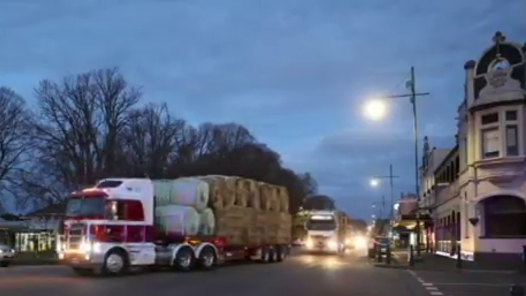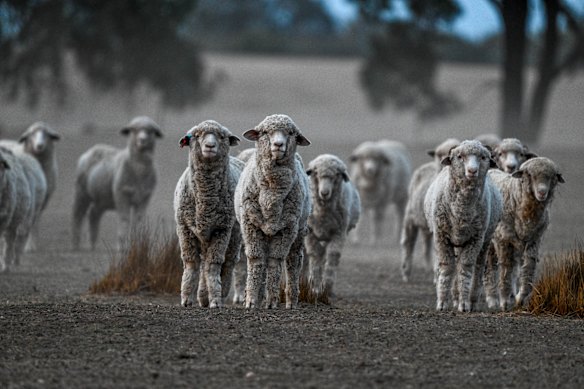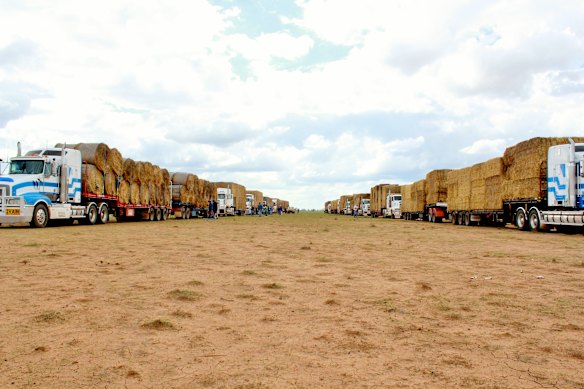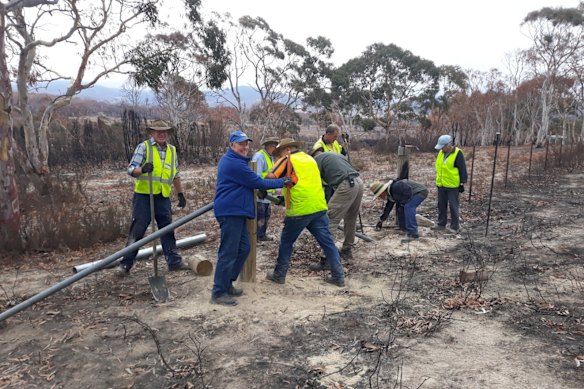By Tony Wright
A convoy of 40 big trucks snorted their way down the main street of the town of Camperdown, 190 kilometres south-west of Melbourne, their headlights carving into the evening.
Bells in the town’s famed old clocktower chimed, police blocked traffic and crowds of locals lined the cold street, cheering and waving their thanks. Tears were shed.

The Need for Feed convey arrives in Camperdown.Credit: Western District Newspapers
At a time when the wider world appears to be devolving into large tribes waging war or, at the least, shouting threats at each other, many of those trucks and what they were hauling, and others like them earlier, symbolised the simplest of old-time country values.
Call it neighbourly love, though plain-spoken farmers and truckies might recoil at such florid talk.
Rain has come and the paddocks have turned green across western Victoria and into South Australia.
It is a vision disguising a continuing disaster.
Shoppers in cities and towns flinch at the rising cost of food, particularly lamb and beef, but out in the countryside, farmers who grow our food are in despair at the rocketing cost of growing it.
Take a drive into the country to the west of Melbourne.
Look closely and you’ll see the green is no more than a thin shroud laid upon what, just a few weeks ago, was bare earth.
Empty paddocks stretch away. Hard-pressed farmers have de-stocked, unable to afford to feed their animals.

The drought is hitting hard in western Victoria.Credit: Joe Armao
But where sheep still graze, their noses are pressed to the ground, their jaws working hard at drawing poor sustenance from the skimpy new growth.
Cattle can’t get their tongues around the mirage of grass.
They stand defeated, waiting to rush the next expensive delivery of hay or grain.
Here is a paradox: a green drought.
As winter came and rain fell, satisfaction at dams filling was curbed by farmers’ knowledge that the weather’s long-awaited turn was a hoax.
After crushing months of the familiar form of dry – the gasping paddocks turning to dusty parchment – the rains came too late, too far into winter’s chill to stimulate anything but phantom growth.
Venture out into these sham green plains of pain and you might come across convoys of trucks loaded with hay – great rolls of it, or big square bales stacked high.
The convoys haul from far away to try to help farmers battle through to spring, when that counterfeit green pick might transform into useful sustenance and debt-wearied land-holders might find the confidence to start rebuilding their flocks of sheep and herds of cattle.
The momentousness of the convoys is that as the cost of hay and grain reaches to the moon, leaving many farmers despairing of making it to tomorrow or ever recovering, the trucks are supplying their loads of hay for free.
The trucks that ground their way to Camperdown last Saturday night brought loads from as far distant as northern NSW worth half a million dollars.
All of it, including the cost of running the trucks and fuel, was at no cost to farmers.
The gift was arranged by the charity Need for Feed Australia, a project of Lions Clubs.
It was established during southern Australia’s worst big dry on record, the millennium drought from late 1996 to 2010.
About halfway through that long agony, a fellow named Graham Cockerell was rocked to read that three farmers a week were taking their own lives.
When he was just 11 years old, he suffered the pain of his own father’s suicide on the family’s farm. His father, like many others, had simply found himself in circumstances he couldn’t control, and couldn’t see a way out.
Cockrell decided he wanted to try to save other families from experiencing his family’s depths of anguish.
And so he arranged to fill a small truck with hay, and he sent it to East Gippsland farmers burnt out in the drought-fuelled fires of 2006-2007.

Farmers helping others in times of need by providing hay has become an established tradition.Credit: Tina Phipps
Since then, with the support of Lions Clubs all over the place, Cockrell’s idea grew into Need for Feed, which became well-known for providing aid following the Black Saturday bushfires of 2009.
Since then, Need for Feed, run totally by volunteers who give their time, trucks, fuel and fodder, has turned up regularly to help communities brought low by Australia’s most familiar catastrophes: droughts, floods and fires.
It estimates it has provided more than $45 million of assistance so far.
Other organisations, like Aussie Hay Runners, do the same sort of thing. Only a couple of weeks ago the Hay Runners ran a convoy of donated hay from East Gippsland to areas around Colac and Hamilton in south-west Victoria.
The motive behind this generosity?
Five years ago, when Western Victoria’s farmers were having a good season, they arranged to send truckloads of hay to help out East Gippsland farmers burnt out in devastating bushfires.
Knowing about suffering, East Gippsland’s farmers decided last month it was time to return the help they had received. In just three weeks, they gathered trucks and hundreds of donated hay bales and set out in convoy from Orbost.
Elsewhere, another disaster relief charity, BlazeAid, raised enough money to cover the freight costs of hay coming from Queensland to western Victoria.

BlazeAid volunteers have also helped fix fences.
Governments, of course, provide disaster relief, too.
But in a drought, the Victorian government doesn’t hand out money for fodder, arguing such a subsidy would send the price of hay and grain spiralling out of reach of farmers everywhere.
And so, good-hearted people of the land, who know firsthand the torment of seeing their animals starving and families falling into despondency and worse, have taken the weight upon themselves to try to alleviate some of the suffering.
It will never be enough, of course.
As climate change forges on, the need for both immediate assistance and long-term innovation towards resilient, sustainable farming can only become more urgent.
For the moment, however, it seems worth knowing that in a world as grim as ours, the old urge in country Australia to help out strangers in need – and let’s call it loving your neighbours – has not surrendered.
The Opinion newsletter is a weekly wrap of views that will challenge, champion and inform. Sign up here.